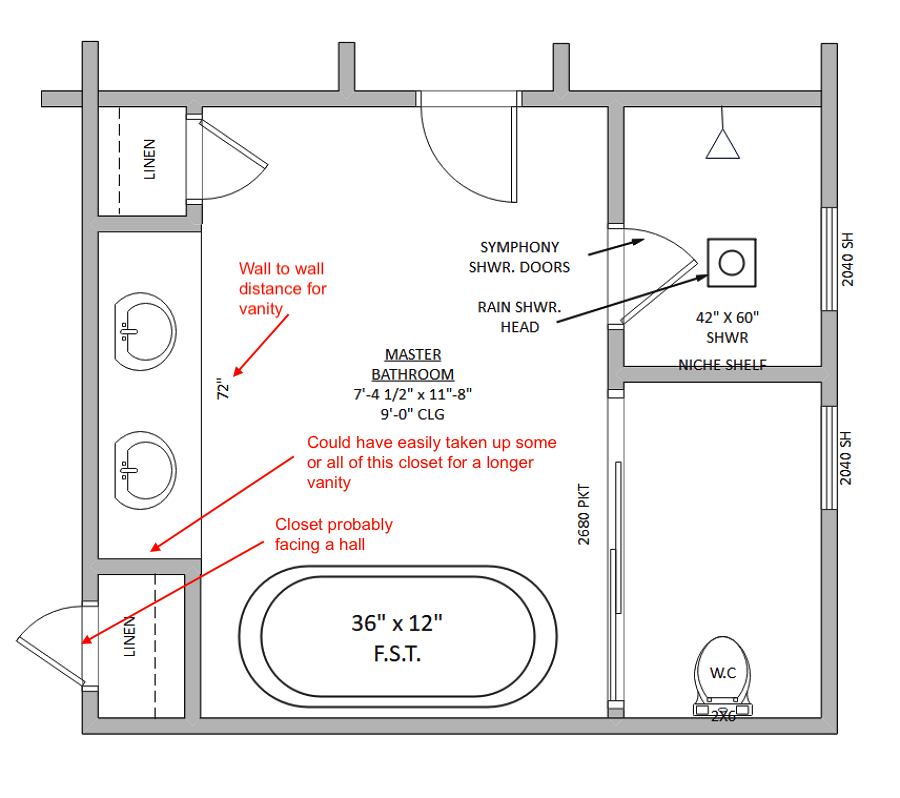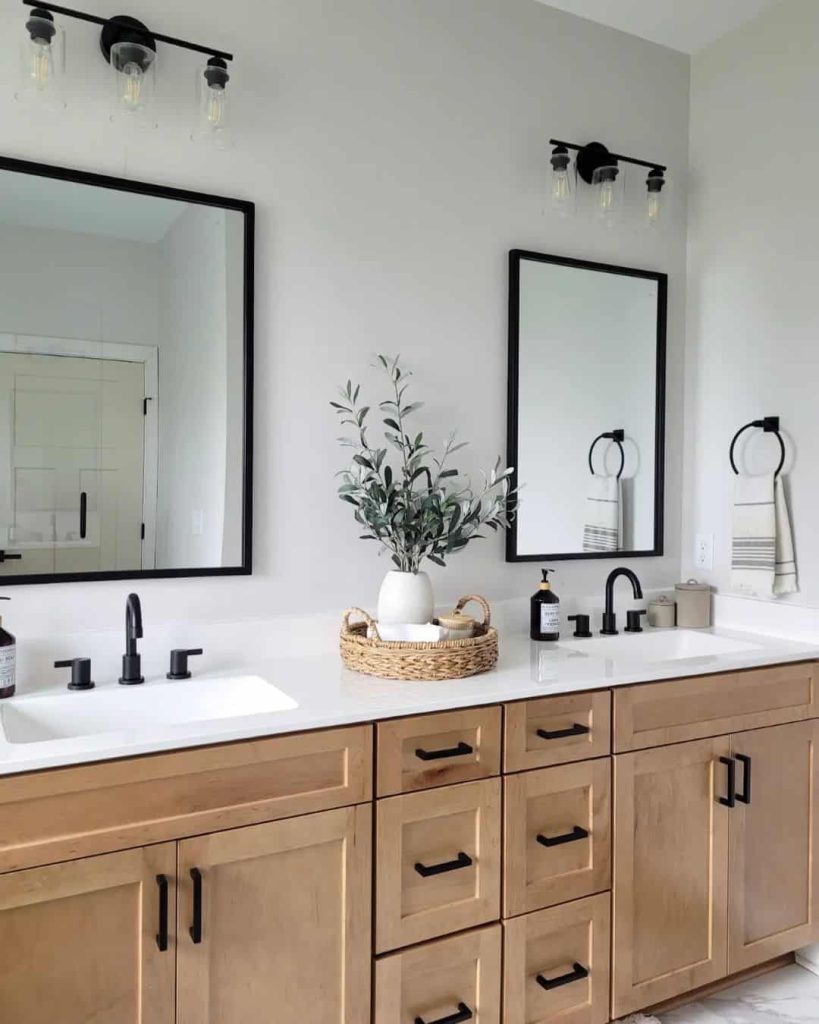How Floor Plans Can PREVENT Mistakes
When house plans are drawn to the homeowner’s actual selections, then mistakes are prevented. That sentence may not make sense to you. Aren’t house plans drawn based on what the owner wants anyway?
During discussions and plan reviews with an architect, owners do make many choices and the plans are drawn accordingly. However, there are many areas where that is not the case. When an owner has not made all of their selections: electrical fixtures, plumbing, cabinets, windows, doors, etc. then the architect or designer is left to guess at what those choices might be.
That’s correct. Much of what you see on a typical set of house plans are guesses (or placeholders) that are drawn in, until the owner decides. As an example, if the owner hasn’t actually shopped for electrical fixtures, then the plans will have ‘standard’ fixture layouts. Maybe it would look like: sconces on either side of the mirrors in the primary bath, one large fixture over the kitchen island, no recessed cans in the dining room and so forth. Looks perfectly fine on the house plans which owners approve.
Later, when the owners actually shop for fixtures, they decide on a 3-light bar fixtures above the mirrors in the bath, 4 pendants over the island and definitely recessed lighting in the dining room. Completely different from the plans.
That super brief description of electrical fixtures speaks to a very unfortunate part of the typical home building process. The typical path (the one that the housing industry lays out for homeowners) has owners ‘make selections’ after construction starts (yikes). That’s when the builder gives the owner a list of selections needed, with a ‘needed by’ date. The list is in phases, based on what is needed to keep construction moving along.
The list is NOT in a good order, for an owner to make design decisions by. It’s also a terrible time frame to prevent ‘mistakes’. As a matter of fact, it encourages changes during construction. Thus, change orders, which cost the owner money (often, big money) and can delay the project.
There are many things wrong with the typical approach, but today I want to show you how ‘mistakes’ happen. These are not mistakes that anyone makes (not the architect, the builder or a subcontractor) because the plans were drawn, approved, then built to what was shown on the plans. Unfortunately, what was shown isn’t always what the owner wanted. These mistakes happen because the typical methodology is NOT good! There are far better ways to go about it.
Let me share one example, of a vanity. Consider, as you read this short story, that owners have hundreds of such choices. All of them have the same potential for mistakes. I preach about the importance of making selections on the front end and having those exact decisions incorporated into the plans. I talk about it being one of the easiest and best ways to prevent mistakes, save money and speed the project along.
Unfortunately, it is hard for owners to actually ‘get it’ because that’s not the common way. Since a picture is worth a thousand words, I thought I’d share a visual of what it looks like when the plans do not match an owner’s choice. Put yourself in these hypothetical owner’s shoes and fast forward to a future point in time when your house is under construction and ‘mistakes’ start to happen.
Here, I’ll walk you through a common scenario regarding one simple vanity decision:
- The architect drew the Master Bathroom for a 72” vanity (located between 2 walls). Owners had not chosen the plumbing fixtures or cabinets yet, but had directed the architect as to what they wanted in the bathroom with a separate shower, freestanding tub and a shared 2 sink vanity.
- During plan review, the diagram (shown below) was given to owners for approval. The owners loved the bathroom layout, which had everything they wanted. The vanity looked big on the plans with 2 sinks and lots of counter space. They wanted it to fit between 2 walls for towel bars and electrical outlets on the end walls. The owners were not aware of any real issue with 72” since it looked like they were getting what they wanted.
The bathroom has a stand alone tub, separate shower and a water closet. Plus, the architect was able to fit an extra linen closet in the hallway! Perfect.

Owners were so excited and looked forward to their beautiful bathroom!
The photo below is one they had posted on their Pinterest board. A true heart’s desire to have the bathroom of their dreams. They looked forward to shopping for those fixtures, although they are definitely going to find better mirrors. The cabinets shown are very close to the look they want. Each owner looked forward to having their own set of drawers too! Tired of sharing one set like they do now, in their current house.

3. The owners signed off on the drawings. Then sets of stamped plans were sent out to bid. Owners decided on a general contractor (the builder), signed the construction contract, a building permit was pulled and home construction started.
4. Their wonderful builder gave them a list of needed selections. First off, was plumbing and electrical fixtures, plus appliances. Those were needed so that pipe and conduit could be run in the right spot, in the slab. Next up was windows and exterior door choices, because their GC said they needed to get those ordered soon since his framers were so fast.
5. Some time passed and the framing was completed, plus the electricians and plumbers ran their pipes and wires for rough-in. The owners started shopping for cabinets. They met with an experienced salesperson at a big Kitchen and Bath supplier.
Disappointment set in. Big disappointment. The salesperson pointed out that the 72” space (currently framed in at their house, with plumbing and electrical rough-in complete) would fit the big sinks they had chosen but with very little counter space around them. She suggested going with smaller sinks like the photo below. The two base cabinets would fit but only one drawer base. Their vanity area would look more like this:

The salesperson did happen to mention that they could wreck the hall closet, reframe that end and have plenty of room to install a longer vanity, as they wanted it to be.
After discussion with the builder, he gave them a change order price to remove the hall closet, reframe the vanity area, move the wiring and light mounts, and rework the plumbing.
Their only choice is to pay a change order to correct the ‘mistake’ or live with something they did not really want.
How would you feel if this was the only choice you were presented with?
Frankly, if I were in those shoes, I’d be p*ssed. Really.
What do you mean I have to pay MORE to get what I want? Especially since there is plenty of room!
It would have been SO very easy for the architect to draw a longer distance for the vanity area when the initial plans were being done. If the architect had known what the owners wanted, he could have drawn the vanity area long enough to fit exactly what they wanted. And, I promise that he could easily sneak a closet (or two) in another part of the hall.
This kind of thing is the tip of the iceberg in typical residential construction (for homeowners). Multiply the problem by the hundreds of areas in a house that rely completely on an owner’s selection of an item. THIS is why there are so many cost overruns in home construction. Not the only reason, of course. But it is a main driver of them.
Fortunately, it is easy to do it another way. Owners can make selections on the front end and have them incorporated into their drawings. In the investor world, that is commonly how it is done.
To clarify that when I say ‘homeowners’, I mean those doing their primary residence. There is also a large percentage of the residential homes being built that are for investors, who sell them. The only real difference between the two owners is the mindset. Investors are willing to (and do) navigate the home building journey differently.
Recently I was talking with an investor that I know. She was in the middle of having the house plans finished and about to put it out to bid. She mentioned that she wouldn’t have any change orders on the project. I asked her how she knew that to be true?
She emphatically replied-
“I have made ALL of my selections and there will be NO change orders!”
Hope this helps and happy building,
Julie
You‘ve got this!
Remember..
- Find your perfect team (banker, designer, architect builder, etc.) who shares the vision
of what you want and how you want it done. - Trust your gut!
- Acquire the right knowledge, at the right time.
- Successfully build your dream!


